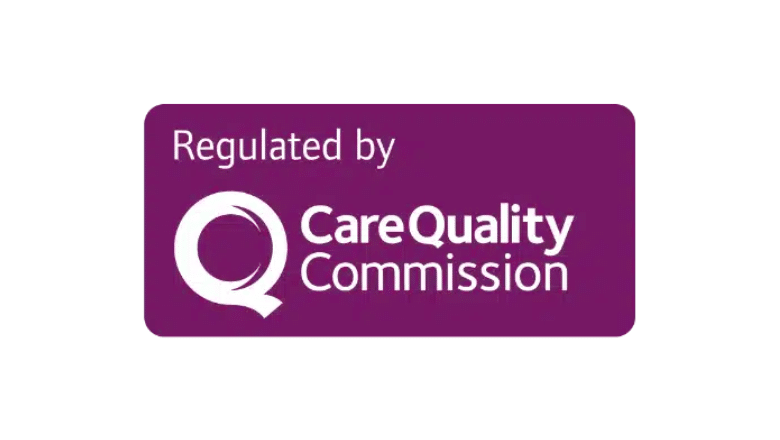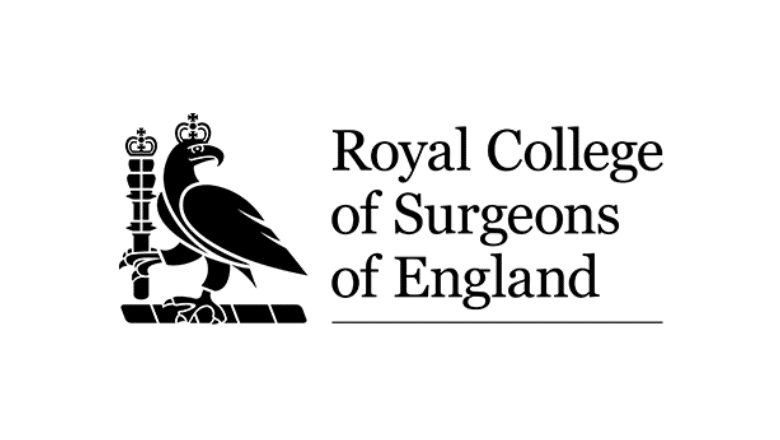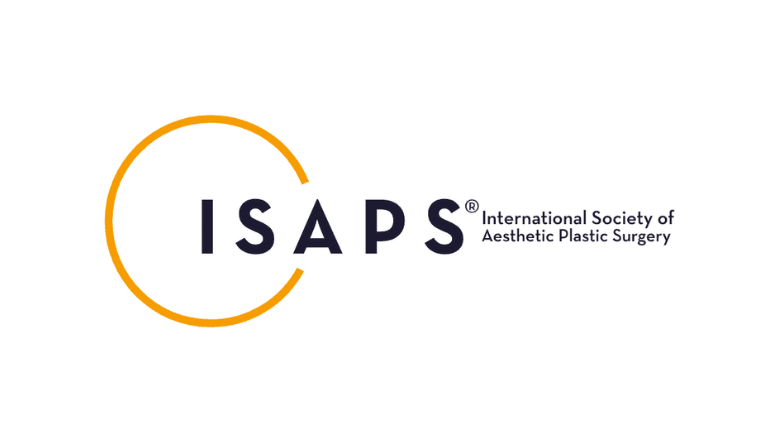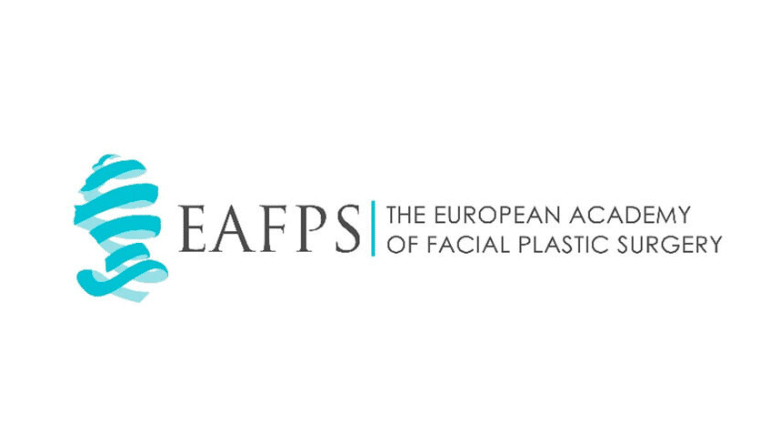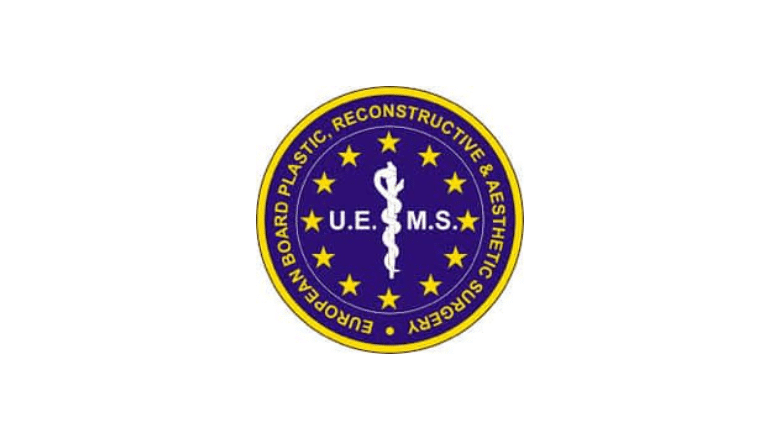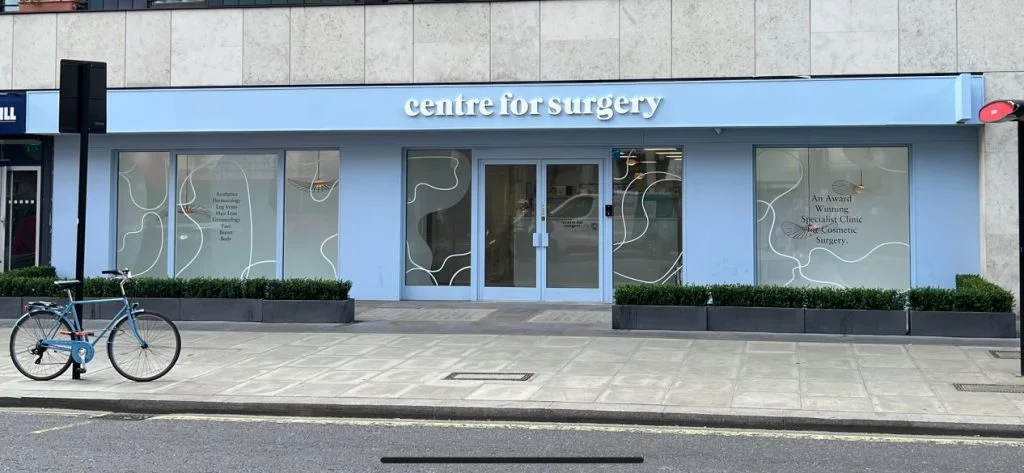- PROCEDURES
- NOSE SURGERY
- Rhinoplasty (Nose Job)
- Tip Rhinoplasty (Tip Plasty)
- Alar Base Reduction (Alarplasty)
- Septoplasty
- Turbinate Reduction
- Septorhinoplasty
- Ethnic Rhinoplasty
- Ultrasonic Rhinoplasty
- Preservation Rhinoplasty
- Revision Rhinoplasty
- Male Rhinoplasty (Nose Job for Men)
- One Stitch Nose Lift
- Nose Surgery FAQs
- Rhinoplasty Gallery
- Non Surgical Rhinoplasty
- Rhinophyma Surgery
- Laser Snoring Treatment (NightLase)
- EYELIDS & FOREHEAD
- Blepharoplasty (Eyelid Surgery)
- Upper Eyelid Surgery
- Lower Eyelid Surgery
- Canthoplasty (Almond Eye Surgery)
- Asian Blepharoplasty (Double Eyelid Surgery)
- Revision Blepharoplasty
- Male Eyelid Surgery (Blepharoplasty for Men)
- Eyelid Surgery FAQs
- Blepharoplasty Gallery
- Tear Trough Filler (Under Eye Filler)
- SmoothEye Laser Treatment
- AccuTite
- Micro & Nano Fat Grafting
- Brow Lift (Forehead Lift)
- Endoscopic Brow Lift
- Temporal Brow Lift (Lateral Brow Lift)
- Hairline Lowering Surgery
- Forehead Contouring Surgery
- Osteoma Removal
- FACE SURGERY
- Full Facelift & Neck Lift
- SMAS Facelift
- Deep Plane Facelift
- Mid Facelift (Cheek Lift)
- Lower Facelift (Jowl Lift)
- Mini Facelift
- One Stitch Facelift
- Revision Facelift
- Male Facelift
- Neck Lift
- Mini Neck Lift
- Male Neck Lift
- Facial Fat Transfer
- Chin & Neck Liposuction
- FaceTite
- Lip Lift
- Lip Reduction Surgery
- Dimple Creation (Dimpleplasty)
- Buccal Fat Removal
- Chin Surgery (Genioplasty)
- Chin Augmentation
- Chin Reduction
- Male Chin Surgery
- EAR SURGERY
- BREAST SURGERY
- Breast Augmentation with Implants
- Mini Boob Job (Mini Breast Augmentation)
- Breast Implant Options
- Breast Implant Check
- Breast Implant Removal (Explant)
- Breast Implant Removal & Breast Lift
- Breast Implant Replacement
- Breast Implant Revision
- Fat Transfer Breast Augmentation
- Hybrid Breast Augmentation
- Breast Lift (Mastopexy)
- Breast Lift with Implants
- Breast Lift with Auto-Augmentation
- Mini Breast Lift (Doughnut Mastopexy)
- Breast Reduction
- Liposuction Breast Reduction
- Inverted Nipple Correction
- Nipple Reduction
- Areola Reduction
- Breast Asymmetry Correction
- Tuberous Breast Correction
- Male Breast Reduction
- Gynecomastia Surgery
- Pectoral Implants
- Chest Wall Implants
- Pectus Excavatum Implant
- Poland Syndrome Implant
- BODY SURGERY
- Ultrasound Assisted Liposuction
- Argo Plasma Skin Tightening
- BodyTite
- Liposuction
- Stomach Liposuction (Tummy Lipo)
- 360 Liposuction
- Micro Liposuction (MicroLipo)
- Tummy Tuck (Abdominoplasty)
- Brazilian Tummy Tuck (Lipoabdominoplasty)
- Mini Tummy Tuck
- Umbilicoplasty (Belly Button Surgery)
- Mons Lift (Monsplasty)
- C Section Scar Revision
- Body Contouring Procedures
- Fat Transfer (Fat Grafting)
- Mummy Makeover
- Calf Augmentation with Implants
- Fat Transfer Calf Augmentation
- BUTTOCK CONTOURING
- Brazilian Butt Lift (BBL Surgery)
- Skinny BBL
- Ultrasound Guided BBL
- 360 Lipo and BBL
- Mini BBL
- Revision BBL
- Male BBL (Brazilian Butt Lift for Men)
- Brazilian Butt Lift FAQs
- Brazilian Butt Lift (BBL) Photos
- BBL Recovery Guide
- Non-Surgical Butt Lift (HYAcorp)
- Buttock Implants
- Butt Implant Removal
- Butt Implants vs BBL
- COSMETIC GYNAECOLOGY
- Labiaplasty (Labia Reduction)
- Clitoral Hood Reduction (Hoodectomy)
- Labia Fat Transfer
- Labiaplasty Photo Gallery
- Labiaplasty FAQs
- Labiaplasty Revision & Reconstruction
- Mons Lift (Monsplasty)
- Vaginoplasty (Vaginal Tightening Surgery)
- Perineoplasty
- Pelvic Floor Repair
- Vaginal Rejuvenation
- Non Surgical Vaginal Tightening
- Vaginal Laser Treatment
- IntimaLase (Vaginal Tightening)
- IncontiLase (Urinary Incontinence)
- ProlapLase (Pelvic Prolapse)
- RenovaLase (Vaginal Dryness)
- Labia Puffing (Labial Puff)
- O Shot Injection
- G Spot Injection (G Shot)
- POST PREGNANCY SURGERY
- Mummy Makeover
- Mummy Makeover Photo Gallery
- Mummy Makeover FAQs
- Argo Plasma Skin Tightening
- Breast Lift (Mastopexy)
- Breast Lift with Implants
- Breast Augmentation with Implants
- Tummy Tuck (Abdominoplasty)
- Brazilian Tummy Tuck (Lipoabdominoplasty)
- Mini Tummy Tuck
- Mons Lift (Monsplasty)
- C Section Scar Revision
- Liposuction
- Stomach Liposuction (Tummy Lipo)
- 360 Liposuction
- Brazilian Butt Lift (BBL Surgery)
- Labiaplasty (Labia Reduction)
- Vaginoplasty (Vaginal Tightening Surgery)
- Non Surgical Vaginal Tightening
- Vaginal Laser Treatment
- POST WEIGHT LOSS SURGERY
- Body Contouring After Weight Loss
- Excess Skin Removal Surgery
- Argo Plasma Skin Tightening
- Tummy Tuck (Abdominoplasty)
- Mons Lift (Monsplasty)
- Extended Tummy Tuck
- Fleur de Lis Tummy Tuck
- Apronectomy (Panniculectomy)
- Breast Lift (Mastopexy)
- Arm Lift (Brachioplasty)
- Thigh Lift (Thigh Reduction)
- Buttock Lift (Gluteal Lift)
- Lower Back Lift
- Bra Line Back Lift
- Upper Body Lift
- Lower Body Lift
- Belt Lipectomy
- Male Body Lift
- MALE SURGERY
- Gynecomastia Surgery
- Male Breast Reduction
- Argo Plasma Skin Tightening
- High Definition Liposuction (HD Lipo)
- Abdominal Etching
- Male Liposuction (Lipo for Men)
- Male Tummy Tuck (Abdominoplasty for Men)
- Pectoral Implants
- Chest Wall Implants
- Pectus Excavatum Implant
- Poland Syndrome Implant
- Calf Augmentation with Implants
- Fat Transfer Calf Augmentation
- Male BBL (Brazilian Butt Lift for Men)
- Male Body Lift
- Male Rhinoplasty (Nose Job for Men)
- Laser Snoring Treatment (NightLase)
- Rhinophyma Surgery
- Male Eyelid Surgery (Blepharoplasty for Men)
- Male Facelift
- Male Neck Lift
- Male Chin Surgery
- GENDER SURGERY 🏳️⚧️
- FTM/N Top Surgery
- Non-Binary Surgery
- FTM Top Surgery Before & After Photos
- Double Incision Top Surgery
- Nipple-Sparing Double Incision Top Surgery
- Keyhole Top Surgery
- Periareolar Top Surgery
- Inverted T Top Surgery
- FTM/N Top Surgery FAQs
- Body Masculinisation Surgery
- MTF Top Surgery
- MTF Breast Augmentation with Implants
- MTF Breast Augmentation with Fat Transfer
- Body Feminisation Surgery
- Facial Feminisation Surgery (FFS)
- Tracheal Shave (Adams Apple Reduction)
- SKIN SURGERY
- Skin Lesion Removal
- Facial Skin Lesion Removal
- Lip Lesion Removal
- Skin Tag Removal
- Mole Removal Surgery
- Cyst Removal Surgery
- Lipoma Removal Surgery
- Dermatofibroma Removal
- Pyogenic Granuloma Removal
- Skin Cancer Surgery
- Osteoma Removal
- Rhinophyma Surgery
- Surgical Tattoo Removal
- Scar Revision Surgery
- Facial Scar Revision
- Micro & Nano Fat Grafting
- Acne Scar Removal
- Hypertrophic Scar Treatment
- Keloid Scar Treatment
- Burn Scars Treatment
- Cellulite Treatment
- Subcision for Cellulite
- Suction Curettage Hyperhidrosis Treatment
- LASER DERMATOLOGY
- Fotona 4D Laser Facelift
- SmoothEye Laser Treatment
- Lip Laser Treatment (LipLase)
- Laser TightSculpting
- Laser Skin Tightening
- Laser Cellulite Treatment
- Erbium Laser Skin Resurfacing
- Laser Acne Treatment
- Rosacea Laser Treatment
- Facial Thread Vein Removal
- Periorbital Vein Laser Treatment
- Veins Under Eyes
- Nose Thread Vein Removal
- Cherry Angioma Removal
- Venous Lake Removal
- Laser Mole Removal
- Wart Removal
- Verruca Removal
- Milia Removal
- Xanthelasma Removal
- Syringoma Removal
- Seborrhoeic Keratosis Removal
- Dermatosis Papulosa Nigra Removal
- Actinic Keratosis Treatment
- Sebaceous Hyperplasia Removal
- Laser Pigmentation Treatment
- Melasma Laser Treatment
- Age Spot Removal
- Laser Scar Removal
- Laser Stretch Mark Removal (LineLase)
- Laser Fungal Nail Treatment
- Laser Snoring Treatment (NightLase)
- Vaginal Laser Treatment
- NON SURGICAL AESTHETICS
- Morpheus8 (RF Microneedling)
- Skin Boosters
- Profhilo Treatment
- Anti Wrinkle Injections
- Frown Lines
- Forehead Wrinkles
- Crow’s Feet
- Bunny Lines
- Lip Flip
- Gummy Smile
- Jaw Slimming Injections
- Anti Sweat Injections
- Muscle Relaxant Injections for Migraine
- Dermal Fillers
- Facial Fillers
- Lip Fillers
- Cheek Fillers
- Nasolabial Folds
- Marionette Lines
- Chin Fillers
- Jawline Fillers
- Temple Filler
- Tear Trough Filler (Under Eye Filler)
- Non Surgical Rhinoplasty
- Liquid Facelift (8 Point Lift)
- Filler Dissolving Treatment
- Double Chin Injections
- Thread Lift
- NOSE SURGERY
- BEFORE & AFTER
- COST & FINANCE
- FAQS & GUIDES
- ABOUT US
- BLOG
- CONTACT US
Breast asymmetry correction is a cosmetic surgical procedure that aims to improve the size, shape, and position of breasts that are uneven in appearance.
Breast Asymmetry Correction London
Breast asymmetry correction in London can make your breasts look more symmetrical
It is common for women in the UK to have some degree of asymmetry between their breasts. However, for some women, this asymmetry can be more noticeable and significant, leading to feelings of self-consciousness and dissatisfaction with their appearance.
RELATED: How To Fix Uneven Breasts – Surgical Solutions for Breast Asymmetry
At Centre for Surgery in London, we understand the impact that breast asymmetry can have on a woman’s self-esteem and confidence. That is why we offer breast enhancement or reduction procedures to correct the size and shape discrepancy, resulting in natural-looking and equally-sized breasts.
Our experienced and skilled surgeons will work with you to develop a personalised treatment plan that takes into account your individual needs and goals. Depending on the severity of the asymmetry, we may recommend breast augmentation or reduction, or a combination of both procedures.
Breast augmentation involves the use of implants to increase the size of one breast to match the other. Our surgeons use only the highest quality Mentor breast implants and offer a wide range of options to suit your needs and preferences.
Breast reduction involves the removal of excess breast tissue and skin to reduce the size of one breast to match the other. This procedure can also improve breast shape and symmetry.

We are committed to providing our patients with safe, effective, and compassionate care. Our state-of-the-art facilities are equipped with the latest technology and equipment to ensure that we provide our patients with the most advanced and effective treatments available.
We understand that breast asymmetry can have a significant impact on your quality of life, which is why we offer a range of breast enhancement and reduction procedures to help you achieve the look and feel you desire. Contact us today on 0207 993 4849 to schedule a consultation and learn more about how we can help you achieve natural-looking and equally-sized breasts.
What is a Breast Asymmetry Correction?
Breast asymmetry correction is a cosmetic procedure aimed at correcting differences in size and shape between the breasts. It is a common issue among women, with almost every woman experiencing some degree of breast asymmetry. However, for some women, the difference in size and shape can be more noticeable, leading to feelings of self-consciousness and dissatisfaction with their appearance.

Breast asymmetry correction can involve a range of procedures, depending on the severity and type of asymmetry. For example, breast augmentation with implants may be recommended to increase the size of one breast to match the other, while breast reduction may be recommended to reduce the size of one breast to match the other.
Other procedures that may be used to correct breast asymmetry include breast lift, which can improve the shape and position of the breasts, and fat transfer, which involves transferring fat from one area of the body to the breasts to improve their size and shape.
Breast asymmetry correction is a highly individualised procedure, and the exact approach will depend on the unique needs and goals of the patient. During a consultation with a qualified plastic surgeon at Centre for Surgery, the patient will undergo a comprehensive evaluation to determine the most appropriate treatment plan for their specific situation.
Tuberous Breast Correction
Tuberous breast correction is a surgical procedure aimed at correcting the deformities associated with tuberous breasts, also known as constricted breasts. This genetic condition can cause significant breast asymmetry, shape abnormalities, and a generally unsightly aesthetic.
Tuberous breast correction involves a range of surgical techniques that can be tailored to the specific needs and goals of each patient. These techniques may include breast augmentation, breast lift, breast reduction, or a combination of these procedures.
Breast augmentation with implants can help to increase the size and volume of the breasts, while also correcting any asymmetry. This procedure involves the placement of silicone or saline implants to improve the overall shape and contour of the breasts.
Breast lift, also known as mastopexy, can help to correct the sagging and drooping that often occurs with tuberous breasts. This procedure involves the removal of excess skin and tissue and the reshaping of the breast mound to create a more lifted and youthful appearance.
Breast reduction may also be recommended for some patients with tuberous breasts, particularly if the breasts are excessively large and cause discomfort or other issues.
Fat Grafting in Tuberous Breast Anomaly Correction
One of the most significant advancements in addressing tuberous breast anomalies is the incorporation of fat grafting. This technique, combined with breast augmentation, enables a more natural breast shape to be achieved by enhancing and restoring volume, particularly in the lower portion of the breast. The use of cutting-edge fat grafting techniques has led to increased fat graft survival and improved cosmetic results.
Fat grafting involves harvesting fat from other areas of the patient’s body, such as the abdomen, thighs, or buttocks, via liposuction. The extracted fat is then purified and carefully re-injected into the breast tissue, providing a natural-looking enhancement to the breasts while simultaneously addressing the shape and volume deficiencies associated with tuberous breast anomaly.
This approach offers several advantages, including:
- Natural appearance: Fat grafting uses the patient’s own fat, resulting in a more natural look and feel compared to synthetic materials like implants.
- Minimally invasive: The procedure involves small incisions and minimal scarring, reducing the risk of complications and promoting faster healing.
- Simultaneous body contouring: The liposuction process used to harvest fat can also help improve the contours of the donor site, providing an additional aesthetic benefit.
- Lower risk of rejection: Since the fat is taken from the patient’s own body, there is a reduced risk of adverse reactions or rejection compared to using foreign materials.
RELATED: How to Fix Breast Asymmetry
Breast Asymmetry Surgery Before and After Photos

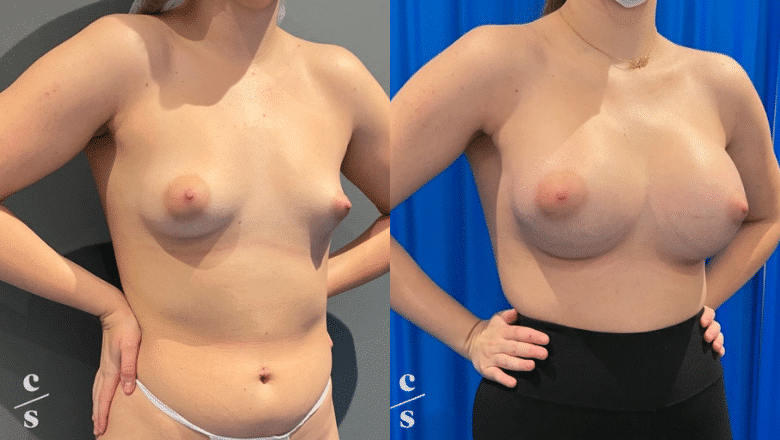
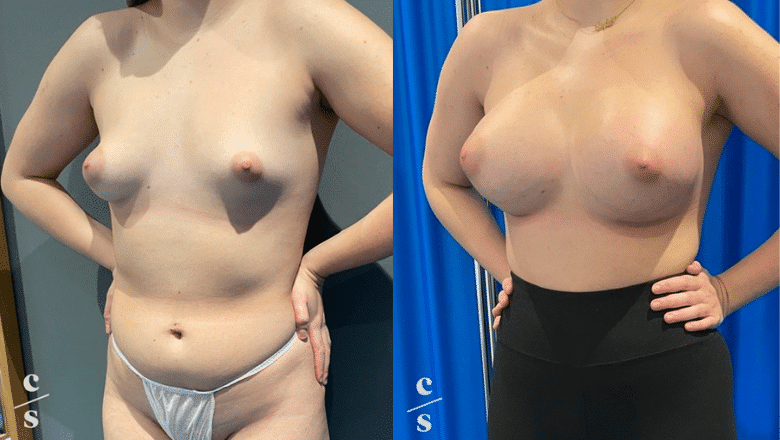
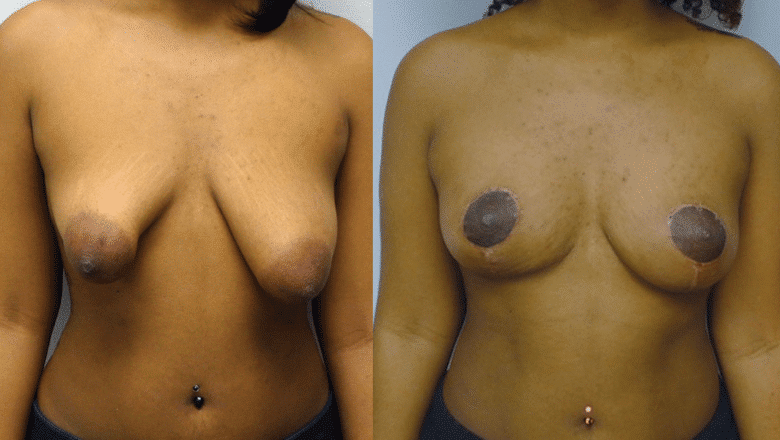
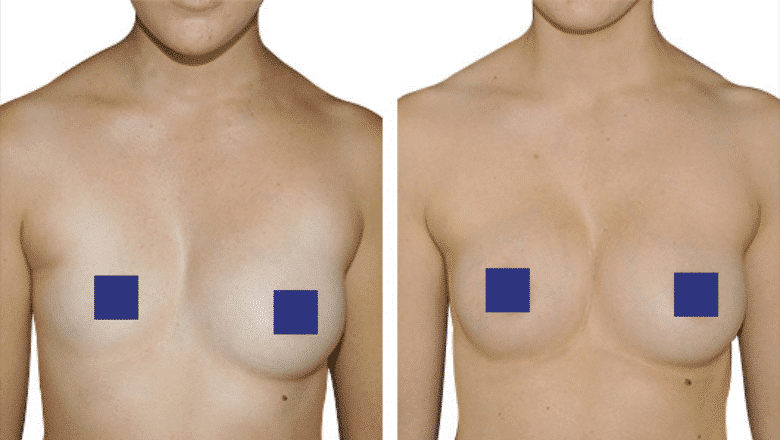

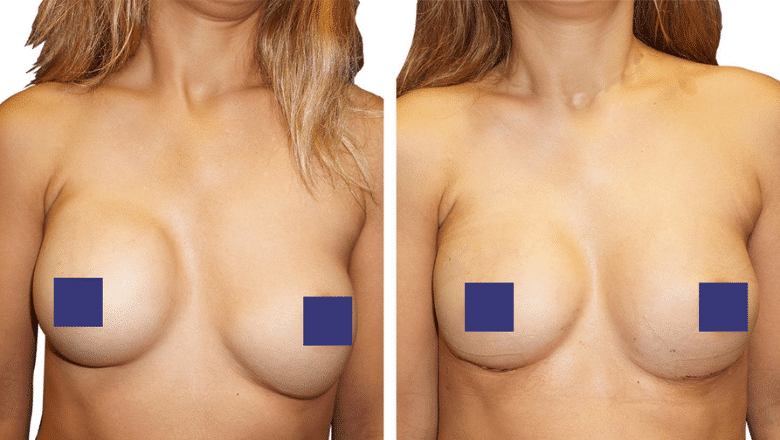
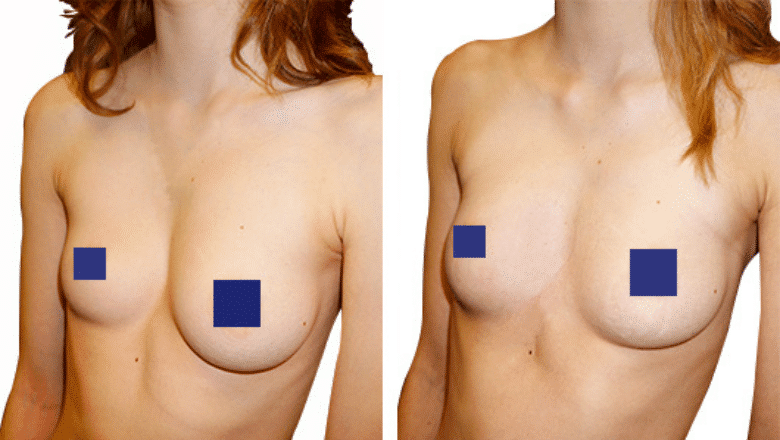
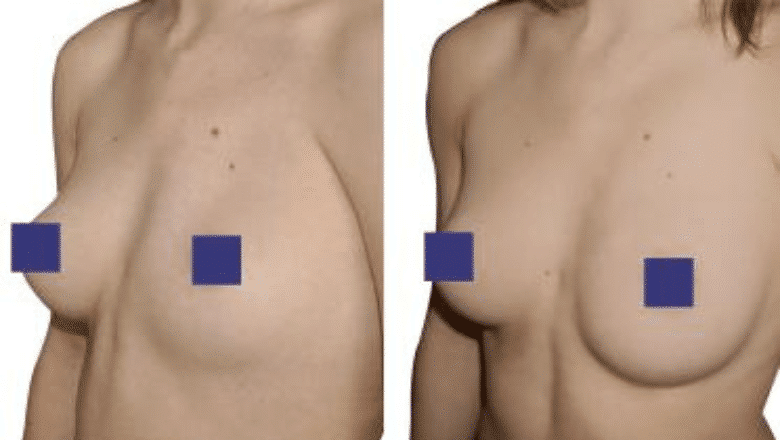
Benefits of breast asymmetry correction
Breast asymmetry correction can provide numerous benefits for women who are dissatisfied with the size and shape differences between their breasts. Here are some of the benefits that breast asymmetry correction can offer:
Improved Self-Esteem
For many women, breast asymmetry can lead to feelings of self-consciousness and low self-esteem. By correcting the asymmetry, women can feel more confident and comfortable in their own skin.
Balanced Appearance
Breast asymmetry correction can provide a more balanced and symmetrical appearance to the breasts, resulting in a more proportionate and aesthetically pleasing figure.
Enhanced Clothing Options
Women with breast asymmetry often struggle to find bras and clothing that fit properly. By correcting the asymmetry, women can have more clothing options and feel more comfortable and confident in their outfits.
Improved Posture
Breast asymmetry can lead to posture issues and back pain. By correcting the asymmetry, women may experience improved posture and reduced back pain.
Long-lasting Results
Breast asymmetry correction procedures can provide long-lasting results, with many women experiencing permanent improvements in breast size and shape.
Increased Comfort
Breast asymmetry can cause physical discomfort, such as breast pain or discomfort while exercising. By correcting the asymmetry, women can experience increased physical comfort and improved quality of life.
Causes of Breast Asymmetry
Breast asymmetry is not a reason for concern – it is a very common occurrence.
There are numerous reasons for breast asymmetry, including hormonal changes, pregnancy, menopause and trauma. It can even be caused by medical conditions such as juvenile hypertrophy of the breast, a rare condition which causes one breast to grow larger than the other.
RELATED: Causes of Uneven or Asymmetrical Breasts
Poland’s Syndrome
Poland’s Syndrome is a congenital condition characterized by significant chest wall asymmetry and underdevelopment of the breast on the affected side. The condition presents a wide range of abnormalities that can impact the chest wall and upper limbs, which may include:
- Absence or underdevelopment of the pectoral component of the pectoralis major muscle
- High nipple position or absence of the nipple
- Narrow chest width on the affected side
- Absent or abnormal ribs or sternum
- Hand abnormalities on the affected side
Most cases of Poland’s Syndrome may be addressed with 3D custom designed implants. However, more severe cases may require extensive reconstruction, utilizing techniques such as tissue expanders with breast implants, fat grafting, latissimus muscle reconstruction, or transverse rectus myocutaneous (TRAM) flap reconstruction.
Rib Cage Abnormalities
Breast asymmetry may be present in women with significant rib cage abnormalities. Deficient or overly prominent ribs can impact breast size and projection, leading to the appearance of larger or smaller breasts on one side. Identifying rib cage asymmetry during consultation is crucial, as it may influence implant selection and the final outcome of breast augmentation procedures.
Breast Hypoplasia
Breast hypoplasia results from underdeveloped breasts during puberty, leading to absent or very small breasts. This is the most common form of breast asymmetry and can usually be corrected by augmenting the affected side. Many women opt for augmentation on both sides using different-sized implants to achieve fuller, more natural-looking breasts that complement their body shape.
While most people have some form of asymmetry, for others the size or shape difference is particularly noticeable. This can not only be damaging to your self-esteem but can cause other problems, such as ill-fitting underwear causing skin problems or physical pain from the weight of the breasts.
Ideal Candidates for Breast Asymmetry Correction
You will be considered a suitable candidate for breast asymmetry correction if you have breasts that are an uneven shape or size and this is detrimental to your self-image.
To have breast asymmetry correction, you will also need to:
- Be 18 years or older
- Be in good physical and mental health
- Have reasonable expectations about what the procedure can achieve
You will also need to be getting the procedure for the right reason, the procedure may not go ahead if surgery is not being completed for the right reasons eg. having surgery to please someone else.
Breast Asymmetry Correction Procedure
A combination of breast lift (mastopexy), breast reduction (reduction mammoplasty), and breast augmentation (augmentation mammoplasty) procedures can be performed to achieve a more balanced, symmetrical, and aesthetically pleasing appearance to the breasts. This is especially beneficial for women experiencing breast ptosis, which is the sagging or drooping of the breasts due to factors like ageing, pregnancy, or weight loss.
The procedure is typically performed under general anaesthesia, and the surgeon will make a small incision in the natural breast crease (inframammary fold) to minimise visible scarring. Depending on the patient’s goals and individual anatomy, the surgeon may choose from a variety of techniques to perform each of the surgeries involved.
Approaches to Correcting Breast Asymmetry
Contemporary advancements in cosmetic breast surgery have made it possible to achieve natural-looking, symmetrical breasts that boost self-confidence and complement one’s body shape. However, it’s important to note that breast asymmetry correction is a complex procedure that necessitates the expertise of a specialist plastic surgeon who can employ a variety of techniques, including:
Breast augmentation using breast implants
A breast implant can be placed to increase the volume of the smaller breast and improve overall breast symmetry. If a woman desires to enhance the size of both breasts, different-sized implants may be used to create symmetry. The preferred method is using the same-sized implant on both sides while performing a breast lift or reduction on the larger side or both sides to achieve the best results in terms of volume and shape.
Breast lift
For women who have one breast that is slightly larger, with the nipple or areola lower than the other breast (often due to breastfeeding), a breast lift on one side only may be performed. However, in most cases, especially for patients with tuberous breast deformity, a breast lift combined with an implant, plus the addition of fat grafting, can be used to enhance both breast volume and shape.
Breast reduction
A breast reduction can be performed solely on the larger breast to match the shape and volume of the smaller breast. If the patient desires a smaller overall size for both breasts, breast reduction can be carried out on both sides, with customisation of the amount of breast tissue removed to achieve symmetry.
Breast tissue modification
For women with significant breast asymmetry, it may be necessary to modify the breast glandular tissue to accommodate a breast implant and expand a tight or constricted breast. Historically, this was done by cutting and reshaping the breast tissue through glandular scoring, which yielded excellent results. With cutting-edge fat grafting techniques, the deficient areas of the breast tissue can be expanded by carefully harvesting the patient’s own fat tissue and re-injecting it into the breast during breast implant surgery. In cases of extreme breast asymmetry, to ensure a more reliable and safe outcome, a staged breast reconstruction may be chosen, involving the use of a breast tissue expander before performing the final breast implant surgery.
RELATED: The Role of Fat Transfer in Treating Breast Asymmetry
Recovery after Breast Asymmetry Correction
The recovery may vary slightly depending on which procedure you undertook – augmentation, uplift or reduction.
After the breast asymmetry correction procedure, it is normal to experience some bruising and swelling, particularly around the incision sites. This may last up to four weeks. You will be given pain medication which can be taken to alleviate any pain and discomfort. You can also use ice packs to help reduce any swelling and bruising in the first few days.
You will be given a compression garment to wear. This will help to reduce any swelling, therefore reducing the recovery period, and help to give you the best results possible.
You must avoid strenuous physical activity. This will help prevent damage to the surgery area. Your surgeon can advise on how long you must avoid physical activity.
You may need to take at least one week off work to recover; however, this will vary from person to person.
Risks and potential complications of breast asymmetry correction
Breast asymmetry correction has been successfully performed for many years with an excellent safety profile. Women should only choose a reputable provider with years of experience in aesthetic breast surgery. With a fully credentialed plastic surgeon at Centre for Surgery, you can be confident in having made the very best choice for breast asymmetry correction coupled with an outstanding package of aftercare to reduce the risk of complications after the procedure.
Risks of Breast Asymmetry Correction
As with any surgical procedure, correction of breast asymmetry has potential risks. These include:
- Bleeding
- Anaesthetic risks
- Infection
- Delayed wound healing
- Skin necrosis
- Nipples that lose sensation
- Breastfeeding difficulties
- Need for revision surgery
Breast Asymmetry Cost London - How Much is Breast Asymmetry Correction in London? Prices & Fees
The cost of breast asymmetry correction in London can vary depending on the specific procedures involved, the extent of the correction needed, and other factors such as the surgeon’s expertise and the facility where the surgery will be performed.
At Centre for Surgery, every surgical procedure is personalised to suit the individual patient’s needs. The team will offer a comprehensive package price that considers the specific type of surgery needed, the expected duration of the operation, and recovery time. The quoted price will cover all necessary aftercare, follow-up appointments, and additional post-operative services required.
Once you have had your initial consultation with the surgical team, you will receive a detailed quote outlining the costs involved. This will include fees for the surgeon, anaesthetist, surgical assistant, and the surgical facility.
The cost of breast asymmetry correction is often not covered by insurance as it is considered a cosmetic procedure. However, Centre for Surgery offers flexible finance options to help make the procedure more affordable for patients.
During a consultation with one of our plastic surgeons, the patient will undergo a comprehensive evaluation to determine the specific procedures needed to correct their breast asymmetry, and the associated costs. Our surgeon will provide a detailed breakdown of the costs involved, including any potential additional fees, to ensure that the patient fully understands the financial commitment involved.
5 Myths About Breast Asymmetry
Breast asymmetry is a common condition that affects many women. It occurs when one breast is different in size, shape, or position. Despite its prevalence, there are still many myths and misconceptions about breast asymmetry that can cause confusion and anxiety. Here are five common myths about breast asymmetry:
Breast asymmetry is rare.
Breast asymmetry is a very common condition affecting women of all ages, ethnicities, and body types. It is estimated that over 50% of women have some degree of asymmetry between their breasts. While breast asymmetry can range from minor to more noticeable differences in size and shape, it is not considered abnormal or a medical problem in most cases.
Breast asymmetry is caused by breast cancer.
Breast asymmetry is usually a normal variation in breast size and shape and is not caused by breast cancer. However, any changes in breast shape or size, including breast asymmetry, should be evaluated by a healthcare professional. Breast cancer can cause changes in breast size and shape, but these changes are usually accompanied by other symptoms such as lumps or dimpling in the skin.
Breast asymmetry only affects older women.
Breast asymmetry can affect women of any age, from puberty through menopause. It is more common in women who have gone through puberty or have had children, but it can also occur in adolescent girls who are still developing. Breast asymmetry can be caused by hormonal changes, genetic factors, or trauma to the breast tissue.
Breast asymmetry cannot be corrected.
There are many ways to correct breast asymmetry, depending on the severity of the condition and the woman’s individual goals. Non-surgical options include the use of padding, inserts, or specially designed bras that can create a more balanced appearance. Surgical options include breast reduction, breast augmentation, or a combination of both. These procedures can improve the size, shape, and position of the breasts, resulting in a more symmetrical appearance.
Breast asymmetry is purely a cosmetic concern.
While breast asymmetry can have a significant impact on a woman’s self-esteem and body image, it can also cause physical discomfort or pain. Women with breast asymmetry may experience back or shoulder pain due to uneven weight distribution, or may have difficulty finding clothing that fits properly. Breast asymmetry can also make it difficult to participate in certain activities, such as sports or exercise. Addressing breast asymmetry can improve a woman’s physical comfort, as well as her mental well-being.
5 Breast Asymmetry Correction Mistakes
Choosing the wrong surgeon
Breast asymmetry correction surgery is a complex procedure that requires a skilled, experienced surgeon. Choosing the wrong surgeon can result in unsatisfactory results, complications, or even health risks. It is important to do thorough research when selecting a surgeon, including verifying their credentials, experience, and reputation. Look for reviews from previous patients and ask for before-and-after photos of their work. Don’t be swayed by low prices or flashy advertisements, as these factors do not necessarily indicate a surgeon’s skill or experience.
Focusing solely on size
While correcting breast size differences is often a primary goal of breast asymmetry correction surgery, it’s important to consider other factors as well. Breast shape and position can also play a significant role in achieving a more balanced, symmetrical appearance. A skilled surgeon will take into account the overall appearance of the breasts and how they fit with the rest of the body, not just the size. Don’t be afraid to ask your surgeon about their approach to achieving a more natural-looking and proportionate result.
Rushing into surgery
It can be tempting to rush into surgery in hopes of quickly correcting breast asymmetry, but taking the time to understand the procedure and potential outcomes is important fully. Schedule consultations with multiple surgeons to better understand the process, and ask questions to clarify any uncertainties. Be sure to review the risks and benefits of the procedure, and take time to carefully consider all options before making a decision.
Neglecting aftercare
Proper aftercare is critical to achieving the best possible results and avoiding complications. Following the surgeon’s instructions for post-operative care is essential for a successful recovery. This may include getting plenty of rest, taking prescribed medications, avoiding certain activities, and wearing compression garments. Neglecting proper aftercare can result in longer recovery times, scarring, and other complications.
Ignoring the possibility of future changes
Breast asymmetry can be caused by various factors, including weight fluctuations, hormonal changes, and ageing. While corrective surgery can provide significant improvement, it’s important to understand that future changes may occur, and additional procedures may be necessary to maintain the desired appearance. Discuss the possibility of future changes with your surgeon, and develop a plan for follow-up care and additional procedures if necessary. Regular check-ups with your surgeon can help monitor changes and ensure the best possible outcomes.
Breast Asymmetry Correction Surgery at Centre for Surgery
At Centre for Surgery in London, we understand the physical and emotional impact that breast asymmetry can have on a woman’s confidence and self-esteem. That’s why we offer a range of surgical options to correct breast asymmetry and achieve natural-looking, balanced results.
Our experienced plastic surgeons will work closely with each patient to develop a personalised treatment plan that addresses their unique needs and goals. The specific procedures recommended will depend on the extent of the asymmetry, the patient’s breast size and shape, and other factors such as skin elasticity and overall health.
Breast asymmetry correction surgery at Centre for Surgery may involve breast augmentation, breast reduction, breast lift, or a combination of these procedures. Our surgeons are skilled in a range of techniques, including breast implant surgery, fat transfer breast augmentation, and breast lift with or without implants. We use the latest surgical techniques and technologies to ensure optimal results with minimal scarring.
We understand that the decision to undergo breast asymmetry correction surgery is a significant one, which is why we offer our patients a comprehensive consultation process. During this consultation, the surgeon will conduct a thorough evaluation of the patient’s breasts, discuss the available options for correction, and provide a detailed explanation of the potential risks and benefits of each procedure.
At Centre for Surgery, we pride ourselves on providing our patients with exceptional care from start to finish. We offer state-of-the-art facilities and the latest technology to ensure the safest and most effective surgical experience possible. Our team of dedicated professionals are committed to providing our patients with the highest level of care and support throughout the entire surgical journey.
FAQs
-
How Can I Correct Breast Asymmetry?Correcting breast asymmetry typically involves undergoing breast asymmetry correction surgery. This specialised procedure is designed to balance the size and shape of the breasts, offering a more symmetrical and aesthetically pleasing appearance. Surgeons may employ various techniques tailored to the individual's specific condition and desired outcome.
-
My breasts are severely uneven, can you help?Yes, we can. Surgeons at Centre for Surgery have many years of experience in breast asymmetry correction surgery.
-
What are the causes of breast asymmetry Breast asymmetry is most commonly due to hormonal changes that may commonly occur as part of puberty but there are also a number of medical conditions that can give rise to asymmetrical breasts including Poland syndrome. Poland syndrome is a congenital defect present from birth that leads to the pectoral musculature on one side of the chest being either undeveloped or missing completely. A possible explanation for this condition may be due to impaired vascular supply whilst in utero. Although Poland syndrome is more common in men it is often more obvious in women after puberty because of the growth and development of the female breast. Most cases of breast asymmetry are not related to Poland syndrome and hormonal causes of breast asymmetry are most common.
-
What Causes Uneven Breast Size?The reasons behind breast asymmetry are varied and can include factors such as breastfeeding, developmental anomalies, hormonal imbalances, genetic syndromes, or issues arising from pregnancy. Understanding the underlying cause is essential for determining the most appropriate treatment approach.
-
Is Breast Asymmetry a Permanent Condition?Breast asymmetry experienced during teenage years may resolve by the time an individual reaches 21. However, if asymmetry continues beyond this age, it is likely to be a permanent condition unless addressed through surgical intervention. Breast asymmetry surgery offers a permanent solution to this issue, creating balanced and harmonious breast appearance.
-
Why Might One Breast Be Larger Than the Other?Natural variation is a common reason for one breast being larger than the other, and it is more widespread than many assume. Factors like breastfeeding, developmental issues, hormonal imbalances, genetic syndromes, or pregnancy can contribute to this asymmetry.
-
What is breast asymmetry?Breast asymmetry occurs when one breast is a different size or shape than the other. This can be caused by numerous factors such as ageing, pregnancy, menopause, hormonal changes or medical conditions.
-
How is breast asymmetry treated?There are numerous different surgical options that can be used for breast symmetry correction. This includes:
Breast augmentation
Breast uplift
Breast reduction
Fat transfer to breasts
You will be able to have a consultation with your surgeon prior to surgery in order to discuss your options and make the best choice for you. -
Can Breast Augmentation Be Performed on Just One Breast?Yes, it is possible to perform breast augmentation on just one breast, which is a common approach for addressing asymmetry. Sometimes, surgeons may recommend using implants of different sizes for each breast to achieve a balanced look. This technique allows for customization to the individual's specific needs.
-
Is there an optimum age for breast asymmetry correction surgery?You need to have fully developed breasts, otherwise any benefit could be undone by further growth.
We do not treat patients below the age of 18 years. -
What type of anaesthetic will be used for breast asymmetry correction?Breast asymmetry correction surgery will be performed under a general anaesthetic. This means you will be asleep and comfortable for your surgery.
-
Will I Experience Pain After the Surgery?Post-surgery, it is normal to experience some pain and discomfort, which can be managed with prescribed painkillers. While there is an expected level of discomfort, especially during the initial week, your surgeon will provide guidance on how to ease this period.
-
What is the Recovery Timeline for Breast Asymmetry Surgery?Recovery experiences can vary, with many individuals starting to feel better within the first couple of days after surgery. However, complete recovery, including the full resolution of swelling and the settling of the breasts into their new shape, can take several months, depending on the surgical techniques used and individual healing processes.
-
Will I have scars following breast asymmetry correction surgery?The level of scarring after breast asymmetry correction surgery depends on the type of procedure to restore breast symmetry. All incisions result in a scar after surgery. Breast enlargement surgery results in a small scar which is positioned in the inframammary fold beneath the breast. Breast lift and breast reduction surgery have more visible scarring that may extend from the nipple to the inferior breast fold. Your surgeon is skilled in all type of breast asymmetry correction surgery and will use techniques to result in scarring that is as cosmetically acceptable as possible. Scars generally fade in appearance over the course of a year. Centre for Surgery are experts in scar revision procedures and have access to the full range of procedures including laser and microneedling to treat prominent scarring.
-
When will I be able to return to work?You may have to take at least one week off work. However, this will vary from person to person, some may need longer while others will feel fine to return to work sooner. This will also vary depending on your type of employment.
-
When can I start exercising again?This will vary depending on which type of procedure you have for breast asymmetry. You may have to avoid strenuous physical activity for at least four weeks following surgery. This is in order to avoid any damage to the operated area.
-
Will I have to wear a garment after breast asymmetry correction?Following the procedure, you will have to wear a compression garment. This will help to reduce symptoms such as bruising and swelling. It will also help to keep the breasts in shape and ensure you can achieve the best results possible.
-
What is the Cost of Surgery to Even Out Breast Size?The cost of surgery to correct breast asymmetry varies widely, depending on the surgical technique employed, the surgeon's experience and expertise, and geographic location. For specific pricing, individuals should consult with our patient coordinator team.
-
Is Additional Surgery Necessary After Breast Asymmetry Surgery?Following breast asymmetry surgery that includes breast augmentation, breast implants typically have a lifespan of around ten to fifteen years. Once this time has passed, it is likely that you will need to undergo a procedure to remove and replace the implants. Factors such as the natural ageing process, pregnancy, childbirth, and gravity can also influence the appearance of your breasts over time. If you experience significant weight loss, it may be necessary to consider additional surgery to maintain your desired breast shape and size.
It is essential to maintain regular follow-up appointments with your plastic surgeon to monitor the condition of your implants and the overall health of your breasts. If any complications or changes arise, your surgeon will be able to address them promptly and recommend appropriate treatment, which may include further surgery if needed. Moreover, maintaining a healthy lifestyle, including a balanced diet and regular exercise, can help to preserve the results of your breast asymmetry surgery for an extended period. -
Are There Any Exercises to Correct Breast Asymmetry?Unfortunately, exercises cannot correct breast asymmetry, as the condition is related to the volume and structure of the breast tissue, which exercises cannot alter. Surgical intervention remains the most effective way to achieve symmetry.
Ask The Expert
Can Breast Reduction Help Prevent Breast Cancer?
Can You Get Breast Implants Under Local Anaesthetic?
MIA Femtech or Breast Augmentation with Local Anaesthetic: Which is Right for You?
How Much Does Areola Reduction Cost?
Sign up to our newsletter
